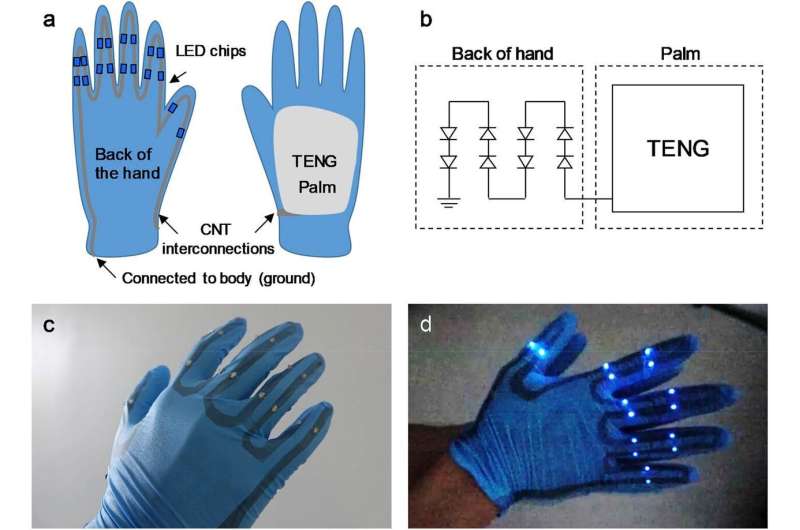Wearable devices powered by body motion using stretchable carbon nanotube thin films

A transparent, stretchable triboelectric nanogenerator (TENG) with area up to 12 cm x 12 cm and power output 8 Watts per square metre, has been realized by Nagoya University researchers using a carbon nanotube thin film (CNT film) as one of the TENG's electrodes. The CNT film was formed using a simple cost-effective and scalable spray-coating method, and applied, as proof-of-concept, to self-powered optical wireless communication sheets and gloves that also power blue LEDs. The work was reported in the journal Nano Energy.
Wearable devices, like smartwatches and activity trackers, have numerous useful functions including information display and biological information sensing. More than half a billion are already being used worldwide, in a wide range of applications such as sports, healthcare, and the human Internet of Things (IoTs) – and this will increase drastically when the 5G telecom revolution fully blossoms. Currently, nearly all such devices are powered by rechargeable batteries, which are relatively bulky and require a fair amount of time for recharging. Moreover, the commonly used Li-ion batteries also face environmental concerns. What if the power source of wearable devices wasn't a battery at all, but a stretchable material that follows the body's motion, and is small and lightweight for user comfort? Energy harvesting technologies that convert small amounts of ambient energy into electrical energy may provide an alternative to batteries for powering wearable devices.
Understandably, stretchable electronic devices have attracted a lot of research and commercial attention recently. Wearable energy harvesters must not only be flexible but also stretchable in order to follow the body's three-dimensional body motion. Moreover, they must deliver sufficient power to drive a variety of electronic devices. However, the output power of harvesters at present is not enough to make stretchable triboelectric generation practical.
A research team from Nagoya University has overcome the stretchability and low output power issue. As first author, Assistant Professor Masahiro Matsunaga, of the Institute of Materials and Systems for Sustainability at Nagoya University, explains, "We have realized a transparent and stretchable triboelectric nanogenerator (TENG) that can follow human motions by using a carbon nanotube thin film (CNT film) as an electrode for the TENG. The fabricated TENG has a simple structure: a CNT film is sandwiched inside a polydimethylsiloxane (PDMS) elastomer. It has a transparency of over 90%."
When the surface of the TENG is touched, the TENG converts mechanical energy into electricity by a process called "contact electrification" and electrostatic induction. The CNT film is made by a simple spray-coating method, which is cost-effective and scalable. The Nagoya University research team can fabricate a large TENG with area up to 12 cm x 12 cm. Moreover, using a plasma treatment during fabrication, the actual, realized power output density of the TENG is up to 8 Watts per square metre.
As a proof-of-concept, the Nagoya University team demonstrated the usefulness of the new TENG by applying it to make self-powered optical wireless communication sheets, and gloves where blue light-emitting diodes (LEDs) were embedded in the TENG and wired using CNT films.
Professor Matsunaga explains further: "For the communication sheets, we formed three separated electrodes and wires with the LEDs of different colours in the sheet. The sheet can send various optical signals depending on the type of touch—tap or swipe."
"To make the glove, we attached the TENG on the palm, and used a CNT wire to connect it to blue LEDs embedded on the back of the hand. The glove can drive LEDs by handclaps. The glove can be put on and taken off without damaging the functionality because of the stretchability and durability of the CNT films."
The new technique for making relatively high power output, stretchable and flexible power generators could be the first step in decreasing our dependence on rechargeable batteries for wearable devices.
More information: Masahiro Matsunaga et al. High-output, transparent, stretchable triboelectric nanogenerator based on carbon nanotube thin film toward wearable energy harvesters, Nano Energy (2019). DOI: 10.1016/j.nanoen.2019.104297
Journal information: Nano Energy
Provided by Nagoya University




















